September
2001 JRS Japan Members' Excursion
to Four Doomed Meitetsu Lines
Page 2
By Hiroshi Naito
To the Yaotsu Line:
The next morning, we were on the same route as previous day to Inuyama
by an express train sitting in longitude style seats. We were visiting
the Yaotsu Line and Takehana Line which were due to close. When we
changed trains at Inuyama, most members shouted for joy. Awaiting us on
the other side of the platform was 1937-built type 3400 in its two-tone
colour livery of dark and light green. Its half-streamlined car style
gave us a quite modern impression along with the interior arranged with
cross seats. We even got to know that this vintage set was
air-conditioned. Our journey on this charming train was up to
Shin-Kani, a ride of about 20 minute through typical half-suburban
scenery with groups of houses surrounded by farm fields of rice and
vegetables. The weather was superb that day with a clear blue sky.
Greenery on low hills and mountains near our route was comfortable for
our eyes. Shin-Kani station was unexpectedly a switchback terminal,
giving us an impression of a pretty complex railway junction. We knew
that the neighboring track was of the JR Okata Line, when a two-car
light diesel railcar came by.
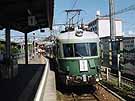
Type 3400 is a 1937-built semi-streamlined EMU, at Shin-Kani
station.
|
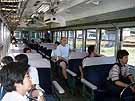
The interior of type 3400 with neatly arranged cross seats.
JRS members are enjoying a ride.
|
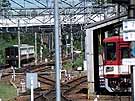
JR Central's two-car light diesel railcar came by along the
neighboring track. On the right is the Akechi LIne's diesel railcar
taking a rest in the shed, at Shin-Kani.
|
Soon, we departed
Shin-Kani for Akechi, the junction to Yaotsu,
which was one of our that day's destinations. After a five minute ride,
we arrived at Akechi and changed to the Yaotsu Line's single unit
diesel railcar. The Yaotsu Line, 9.1 km in length, was originally
electrified, but in 1982, it was switched to railbus operation to cut
back on operation costs. Our diesel railcar was type 30, quite similar
to those common among most third-sector railways all over Japan. Like
the day before, the car was crowded with railway enthusiasts who came
to have their last ride. The railcar proceeded rumbling along jointed
rails on a poor weed grown single track. The surrounding scenery now
turned rustic enough, and our car ran along a gently ascending route
through a bit mountainous landscape. Although catenary was taken away
on dieselization, steel-made catenary pillars were still standing along
the track. Yaotsu was a stub end surrounded with woods and traditional
tile-roofed houses in a rustic village, which gave me the feeling of
good old Japanese countryside. It was a photography time for us,
targeting the diesel railcar going away and coming up 30 minutes later.
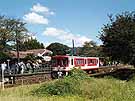
Yaotsu Line's diesel railcar standing at Yaotsu station under
a blue sky.
|
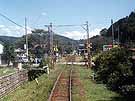
Weed grown Yaotsu Line track in rustic scenery. Although the
catenary was taken away, steel made catenary pillars still stand along
the track.
|
|
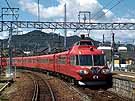
Type 7000 Panorama Car at Shin-Unuma. Having a control cab
above the passenger cabin, passenegers can enjoy a panoramic view ahead
from the front car. Taken from the front-most seat on type 7000 in the
opposite direction.
|
Type 7000 Panorama Car:
After visiting the Yaotsu Line, we came back to Inuyama taking the same
route as on our way. At Inuyama, we caught an express of type 7000
Panorama Car for Shin-Gifu along the Kagamihara Line again. Having a
control cab above the passenger cabin at both ends, this type provides
observation space to passengers for the front view. Nowadays, this type
of a feature is pretty common on several routes on both JR and private
railways, but most of them are in express or limited express service
requiring a surcharge. However, on Meitetsu with this type you can
comfortably enjoy a panoramic view ahead free of additional charge.
Being first introduced in 1966, the type 7000 took the initiative of
this service feature in Japan. However, due to their age, it is
inebitable that they are disappearing in the near future. Thinking that
it was a good chance to experience a front view from this type, I went
to the front-most car. Some members followed me and took a good
position for the panoramic view. Feeling quicker than the same trip
yesterday, we arrived in Shin-Gifu, where we took the Nagoya Main Line
on the elevated track to go to our next destination.
To Takehana Line:
After a ride of about several minutes on a local, we got to Kasamatsu,
the junction for the Takehana Line, our last destination. The Takehana
Line was completed in 1929 by the Takehana Railway and became part of
Meitetsu with a wartime mandated merger in 1943. The line runs down
southwards in a triangle area sandwiched by the Nagara River and Kiso
River up to Osu near the junction where both rivers converge. The 8.4
km long southern-most leg of the line between Egira and Osu is closing
in this month (September). Our train was a local for Osu. The line was
on single track all the way. Some members stood behind the cab to catch
the front view. It is the best way to take this position to grasp
feeling of a route and its circumstances. Along the line was rather
suburban as far as Egira. Egira is the Takehana Line's secondary
junction where a short branch line, about 1.2 km in length, diverges to
reach the Tokaido Shinkansen's Gifu-Hajima station. I was impressed
with the simple structure of the diverging point that was composed of a
single turnout installed on the single track.
Just after leaving
Egira, going below the Tokaido Shinkansen's
embankment, we entered the closing segment of the line. Now, the
ambience grew more rustic, and we got a desolate feeling whenever we
stopped at an unattended intermediate station. Passenger exchanges were
only a few at each station. Houses seen alongside were traditional
tile-roofed, and matching the surrounding rice fields, they were
producing the feeling of Japan's typical rural scenery. After an about
30 minutes journey from Kasamatsu, we finally arrived at Osu. Osu was a
simple stub end terminus in a quiet town located near the bank of the
Nagara River. On the platform and alongside of the track outside the
station were a number of railway enthusiasts photographing the last
operations of the line.
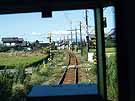
Along the Takehana Line was a Japan's typical rural scenery
with traditional tile-roofed houses, matching the surrounding rice
fields.
|
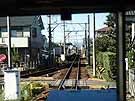
The branch to the Shinkansen Gifu-Hajima station was by simple
structure with a single turnout installed on the single track.
|
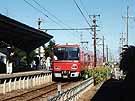
Osu station was a stub end in a quite town located near the
bank of the Nagara River.
|
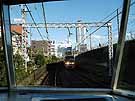
Approaching Shin-Nagoya on Meitetsu Nagoya Main Line entering
the underground section. The skyscraper ahead is JR Central's newly
completed station building.
|
Epilogue:
Thus, we finished our activities, having been satisfied with train
rides on Meitetsu's countryside lines. We got back to Kasamatsu sitting
in longitude style seats on a local train. At Kasamatsu, we took an
express of type 7000 again towards Shin-Nagoya. Sitting comfortably in
the front-most seat in the Panorama Car, I enjoyed the running along
Mitetsu's busy main line at a maximum speed of 120 km/h.
Back to Page 1
All photos in
this page were taken by the author in September 2001.
[Home Page]









